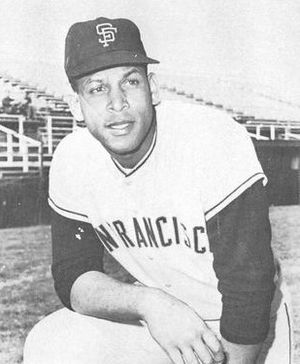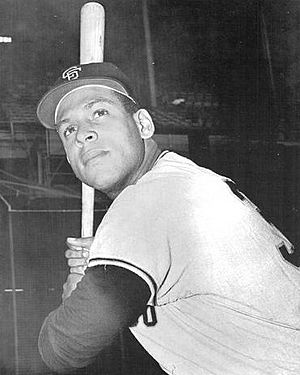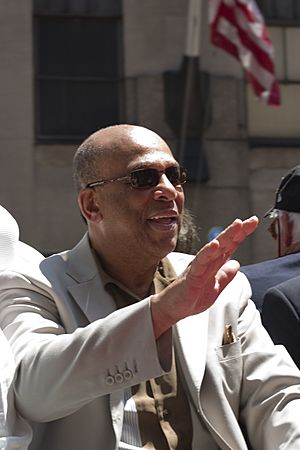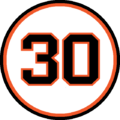Orlando Cepeda facts for kids
Quick facts for kids Orlando Cepeda |
|||
|---|---|---|---|

Cepeda with the San Francisco Giants in 1965
|
|||
| First baseman | |||
| Born: September 17, 1937 Ponce, Puerto Rico |
|||
| Died: June 28, 2024 (aged 86) Concord, California, U.S. |
|||
|
|||
| debut | |||
| April 15, 1958, for the San Francisco Giants | |||
| Last appearance | |||
| September 19, 1974, for the Kansas City Royals | |||
| MLB statistics | |||
| Batting average | .297 | ||
| Hits | 2,351 | ||
| Home runs | 379 | ||
| Runs batted in | 1,365 | ||
| Teams | |||
|
|||
| Career highlights and awards | |||
|
|||
| Induction | 1999 | ||
| Election Method | Veterans Committee | ||
Orlando Manuel Cepeda Pennes (September 17, 1937 – June 28, 2024) was a famous first baseman in Major League Baseball. People called him "the Baby Bull" and "Peruchin". He played for six different teams from 1958 to 1974, mostly for the San Francisco Giants.
Orlando was an All-Star 11 times. He was one of the best power hitters in the National League (NL) during the 1960s. When the Giants moved to San Francisco, he joined them. In 1958, he was named the NL Rookie of the Year. He hit .312 with 25 home runs and 96 runs batted in (RBIs). He also led the NL with 38 doubles.
From 1958 to 1963, Orlando was always among the league leaders. He was great at batting, hitting home runs, and getting RBIs. In 1959, he was the first player from Puerto Rico to start an All-Star Game. In 1961, he was almost the NL Most Valuable Player (MVP). That year, he led the league with 46 home runs and 142 RBIs. This is still a team record for right-handed hitters.
Later, the Giants had two great first basemen: Orlando and Willie McCovey. The team tried to make them play left field sometimes. Orlando had knee injuries and missed most of the 1965 season. He was traded to the St. Louis Cardinals in 1966. He finished that year with a .301 batting average.
In 1967, Orlando had his best year, hitting .325 with 25 home runs. He led the league with 111 RBIs. He helped his team win the NL championship. He also won the MVP Award that year. Later, he was traded to the Atlanta Braves. He helped them win their division in 1969. Orlando hit 254 home runs and had 896 RBIs in the 1960s. This was fifth best among NL hitters.
Because of his knee problems, he moved to the American League. He won the first Outstanding Designated Hitter Award with the Boston Red Sox in 1973. His career ended the next year. Orlando hit over .300 nine times in his career. He finished with a .297 batting average. He also had five seasons with 30 home runs and 100 RBIs.
In 1987, the Giants hired Orlando as a scout and ambassador. He started doing a lot of good work for people. In 1999, Orlando Cepeda was put into the Baseball Hall of Fame.
Contents
Early Life in Puerto Rico
Orlando Cepeda was born in Ponce, Puerto Rico. His parents were Pedro Aníbal Cepeda and Carmen Pennes. His family was not rich. They lived in simple wooden houses.
His father, Pedro, was a professional baseball player in Puerto Rico. People called him "Perucho" and "The Bull." Many thought he was one of the best players of his time. Because of his father, Orlando was known as "The Baby Bull." Orlando first saw his father play baseball in 1946. He loved the game right away.
Pedro Cepeda could not play in the major leagues because he was black. This was before Jackie Robinson broke the color barrier in 1947. Many players from the Negro leagues visited their home. This made Orlando love baseball even more. He looked up to players like Minnie Miñoso.
When Orlando was 10, he sold newspapers to join a baseball tournament. Three years later, he tried out for a team but did not make it. He then played basketball. He hurt his knee and needed surgery. The doctor told him not to play basketball anymore. So, he went back to baseball. He noticed he was much stronger now.
An amateur player saw him play and asked him to join his team. They won Puerto Rico's amateur championship. Then, they played against a team from the Dominican Republic. Pedro Zorilla, who owned the Santurce Crabbers, saw Orlando play. He was very impressed. In 1953, Zorilla hired Orlando to be a batboy for his team.
After his father retired, he worked for the government. He got sick and passed away at age 49. This made things harder for the family. They moved to different towns, and their money problems got worse. His mother worked hard to support them. Since there wasn't enough money for college, Orlando focused on baseball.
Starting His Professional Baseball Journey
Minor League Baseball
In 1955, Pedro Zorilla helped Orlando go to a tryout for the New York Giants. He passed the tryout and was sent to a low-level team called Sandersville. Then he moved to the Salem Rebels. It was hard for him because he didn't speak English. He also faced unfair treatment because of racial segregation.
Soon after, his father got very sick and died. Orlando paid for the funeral and went back to Salem. He was very sad, and it affected his playing. He wanted to quit, but Zorilla convinced him to play for the Kokomo Giants. His manager, Walt Dixon, made him play third base. Orlando played great, hitting .393 with 21 home runs and 91 RBIs.
Jim Tobin, who owned Orlando's contract, saw his talent. He sold Orlando's rights back to the Giants. After visiting Puerto Rico, Orlando went to play for the St. Cloud Rox. They moved him to play first base. Orlando quickly got used to the new position. That year, he won the Northern League Triple Crown. He hit .355 with 112 RBIs and 26 home runs.
He then played for the Crabbers in Puerto Rico during the winter. He hit .310 with 11 home runs. The Giants invited him to spring training with other young players. This was after the team moved from New York to San Francisco.
Playing for the San Francisco Giants (1958–1966)
Orlando Cepeda joined the San Francisco Giants in 1958. He signed his first major league contract just before his first game. He earned $7,000 for the season. The team raised his salary to $9,500 in June because he played so well.
He lived with teammate Rubén Gómez for a while. His batting average stayed high, never dropping below .305. The Giants were in the race for the championship for a month. They finished third that year.
In his first season, Orlando hit .312 with 25 home runs and 96 RBIs. He also led the league with 38 doubles. He and Willie Mays were the only NL players to be leaders in many hitting categories. Everyone voted for him to be the NL Rookie of the Year. He was the second player ever to win this award with a unanimous vote.
After the season, Orlando used his money to buy a new house for his mother. He also won the Puerto Rican league batting title. The Giants offered him a new contract for $12,000, but he asked for more. They agreed on $17,000.
In 1959, Orlando felt more confident. He started the season with hits in nine straight games. He was chosen to start in both All-Star games that year. The Giants tried moving him to third base, then to the outfield. He hit six home runs in August and September. The Giants finished third again. Orlando led the team with a .317 batting average and 105 RBIs.
In 1960, the Giants moved him back to first base. He finished with a .297 average, 24 home runs, and 96 RBIs.
The year 1961 was one of Orlando's best. He led the league in RBIs (142) and home runs (46). On July 4, he had an amazing game against the Chicago Cubs. He got five hits, including two doubles and a huge three-run home run. He drove in eight runs in that game. He was chosen for the All-Star Game again. The Giants finished third. Orlando came in second for the Most Valuable Player award.
In 1962, the Giants were much better. They were always battling the Los Angeles Dodgers for the league lead. Orlando played in the All-Star Games again. The Giants tied with the Dodgers and won a special playoff series. This sent them to the World Series against the New York Yankees. The Yankees won in seven games. Orlando hit .306 with 35 home runs and 114 RBIs that year.
Orlando had some problems with his manager, Alvin Dark. Dark told the Latin American players to stop speaking Spanish. Orlando stood up to him. After this, Dark often left Hispanic players out of team meetings.
In 1963, Orlando hurt his knee while training in Puerto Rico. He played the whole season with the injury. He didn't tell the Giants because he was worried about his spot on the team. He was in pain but still played well. He hit .316 with 34 home runs and 97 RBIs. Before he turned 26, he had over 1,100 hits.
In 1964, the Giants were in the championship race until the last week. Orlando led the team with a .304 batting average. In 1965, his knee problems got worse. Doctors told him to stop playing, but he needed the money. He tried different treatments. He only played a few games and hit .176 with one home run. He went back to Puerto Rico for more therapy. He recovered and went to spring training in 1966, but he wasn't in the starting lineup.
Joining the St. Louis Cardinals (1966–1968)
In May 1966, the Giants traded Orlando to the St. Louis Cardinals. The Cardinals needed better offense. Orlando got a new contract for $53,000. He finished his first season with the Cardinals hitting .303. He was named the NL Comeback Player of the Year.
In 1967, the Cardinals started the season strong. Orlando drove in seven runs in the first four games. The team fined players who left teammates on base. This money paid for their end-of-season party. The Cardinals took control of the championship race. Orlando played in his seventh All-Star Game. He was named NL Player of the Month in August. He hit .352 with 5 home runs and 25 RBIs.
The Cardinals won the championship by 10.5 games. They beat the Boston Red Sox in seven games to win the World Series. Orlando hit .325 with 21 game-winning hits. He led the league with 111 RBIs. He was named the National League Most Valuable Player. He was the first Latin player to win the home run and RBI titles.
In 1968, the Cardinals were seen as the best team. They won the championship again. Orlando hit a home run in the World Series. But the Detroit Tigers won the series. This year was called the "Year of the Pitcher" because pitchers were so dominant. Orlando had a tough year, hitting .248 with 16 home runs. He showed up late to spring training in 1969.
Playing for the Atlanta Braves (1969–1972)
Before the 1969 season, the Cardinals traded Orlando to the Atlanta Braves. He was surprised and thought about retiring. But he decided to keep playing after talking with his wife.
Orlando moved to Atlanta. He was welcomed by Hank Aaron. On August 4, Orlando hit his 300th career home run. Baseball had new playoffs that year. The Braves won their division but lost to the New York Mets. Orlando hit .257 with 22 home runs and 88 RBIs.
In 1970, Orlando hit .305 with 34 home runs and 111 RBIs. On July 11, he got his 2,000th hit. On July 26, he hit three home runs in one game, driving in seven runs. One of them was a grand slam. The Braves pitching wasn't great, and they finished fourth.
In 1971, Orlando started well, hitting 10 home runs by May. But he hurt his knee again at home. Doctors said the injury was serious. He started playing part-time. His batting average dropped, and he only hit five more home runs. He had surgery in New York and recovered in Puerto Rico. In 1972, he still felt pain. The team's general manager decided to trade him.
Short Stays with Other Teams (1972–1974)
In July 1972, Orlando was traded to the Oakland Athletics. He played for a week as a pinch hitter. Then he had a second surgery on his knee. He stayed in Oakland for three months before going back to Puerto Rico. The Athletics' owner told him he would be released if he didn't respond. Orlando decided not to call, planning to retire.
In 1973, the American League started using the designated hitter rule. This meant a player could bat without playing defense. The Boston Red Sox contacted Orlando. They told him he would only need to bat. He became the first player to sign a contract just to be a designated hitter. His first hit with the team was a walk-off home run that won the game. He hit a career-high four doubles and six RBIs in another game.
Orlando finished the year hitting .289 with 20 home runs and 86 RBIs. He won the Outstanding Designated Hitter Award. His 20th home run made him the first player to hit 20 or more home runs with four different teams.
After playing briefly in Mexico, the Kansas City Royals offered him a contract. In his last season in 1974, Orlando hit .215 with 1 home run and 18 RBIs.
Orlando was the second player from Puerto Rico to win a Triple Crown in Minor League Baseball. He was an All-Star seven times, playing in 11 games. He was the first Puerto Rican to start in an All-Star Game. He was also chosen for two positions: first baseman and left fielder. In the Puerto Rican Professional Baseball League, he had a .325 batting average. He hit over .300 nine times in his career.
Orlando's Life Outside Baseball
On December 3, 1960, Orlando married Annie Pino. They had a big party after the ceremony. They later divorced in 1973.
After that, he met Nydia Fernandez. They married in 1975 and had two children, Malcom and Ali. Orlando also had two other sons, Orlando Jr. and Carl.
Orlando became a Buddhist in 1983. He moved to Los Angeles. His relationship with Nydia ended. He later married Mirian Ortiz, who passed away in 2017.
Orlando's Legacy and Honors
 |
|
| Orlando Cepeda's number 30 was retired by the San Francisco Giants in 1999. |
In the 1990s, many people from Puerto Rico wanted Orlando to be in the Baseball Hall of Fame. Other famous people and former teammates also helped. In 1994, he was very close to being elected. In 1999, he was finally voted into the Baseball Hall of Fame. He joined Roberto Clemente as the only Puerto Ricans there at the time. Later, Roberto Alomar, Iván Rodríguez, and Edgar Martínez also joined them.
Orlando belongs to 14 different halls of fame. This is the most for any Puerto Rican athlete. He is in the Baseball Hall of Fame in Cooperstown, and many sports halls of fame in Puerto Rico and other places.
Orlando was also known for his good work helping people. He was an ambassador for baseball. He spoke for the Crohn's and Colitis Foundation of America.
In 2001, he won an award for his positive image and lifetime achievements. He visited schools and hospitals. He talked to kids about staying away from trouble. He was loved in his community.
The Giants retired Orlando's number 30 in 1999. His number hangs at Oracle Park, the Giants' stadium. On September 6, 2008, the Giants put up a statue of Orlando at the stadium. He was the fifth Giant to get a statue. The others are Willie Mays, Willie McCovey, Juan Marichal, and Gaylord Perry. Orlando continued to work with the Giants team.
He was also honored in Ponce, Puerto Rico, in a special park for famous people.
Health and Passing
In February 2018, Orlando was hospitalized after a fall. He had a "cardiac episode" and a stroke. He was in the hospital for several months.
Orlando Cepeda passed away on June 28, 2024, at 86 years old. His death happened just 10 days after his former teammate Willie Mays died.
See also
 In Spanish: Orlando Cepeda para niños
In Spanish: Orlando Cepeda para niños
- Players from Puerto Rico in MLB
- List of Puerto Ricans
- Major League Baseball Home Run Leaders
- Major League Baseball Hits Leaders
- Major League Baseball RBI Leaders
Images for kids







